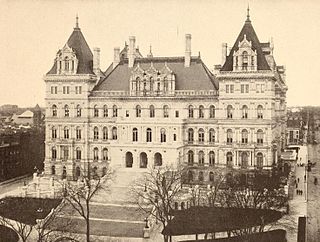Elections
The 1918 New York state election, was held on November 5. This was the first election at which women had the right to vote, and the right to run for elective offices. [1] Two women were elected to the State Assembly: Ida B. Sammis (Rep.) and Mary M. Lilly (Dem.).
Al Smith and Harry C. Walker were elected Governor and Lieutenant Governor, both Democrats. The incumbent Governor Charles S. Whitman ran on the Republican and the Prohibition tickets for re-election, but was defeated by Smith in a tight race, with a plurality of about 15,000 votes out of more than two million.
The other five statewide elective offices up for election were carried by the Republicans. The approximate party strength at this election, as expressed by the vote for Governor, was: Democrats 1,010,000; Republicans 956,000; Socialists 122,000; Prohibition 39,000; and Socialist Labor 5,000.
In New York City, where in November 1917 ten Socialists had been elected to the Assembly by pluralities in three-way races, Republicans and Democrats combined to stem the "red flood", and nominated joint candidates in most of the "Socialist" districts. Thus they managed to outpoll the Socialists in eight of the ten districts; only two Socialists, August Claessens and Charles Solomon, managed to get elected.

The 122nd New York State Legislature, consisting of the New York State Senate and the New York State Assembly, met from January 4 to April 28, 1899, during the first year of Theodore Roosevelt's governorship, in Albany.

The 125th New York State Legislature, consisting of the New York State Senate and the New York State Assembly, met from January 1 to March 27, 1902, during the second year of Benjamin B. Odell Jr.'s governorship, in Albany.

The 126th New York State Legislature, consisting of the New York State Senate and the New York State Assembly, met from January 7 to April 23, 1903, during the third year of Benjamin B. Odell Jr.'s governorship, in Albany.

The 128th New York State Legislature, consisting of the New York State Senate and the New York State Assembly, met from January 4 to July 20, 1905, during the first year of Frank W. Higgins's governorship, in Albany.

The 130th New York State Legislature, consisting of the New York State Senate and the New York State Assembly, met from January 2 to July 26, 1907, during the first year of Charles Evans Hughes's governorship, in Albany.

The 131st New York State Legislature, consisting of the New York State Senate and the New York State Assembly, met from January 1 to June 11, 1908, during the second year of Charles Evans Hughes's governorship, in Albany.

The 134th New York State Legislature, consisting of the New York State Senate and the New York State Assembly, met from January 4 to October 6, 1911, during the first year of John Alden Dix's governorship, in Albany.

The 135th New York State Legislature, consisting of the New York State Senate and the New York State Assembly, met from January 3 to March 29, 1912, during the second year of John Alden Dix's governorship, in Albany.

The 136th New York State Legislature, consisting of the New York State Senate and the New York State Assembly, met from January 1 to December 12, 1913, while William Sulzer, and then Martin H. Glynn, were Governor of New York, in Albany.

The 137th New York State Legislature, consisting of the New York State Senate and the New York State Assembly, met from January 7 to May 20, 1914, while Martin H. Glynn was Governor of New York, in Albany.

The 138th New York State Legislature, consisting of the New York State Senate and the New York State Assembly, met from January 6 to April 24, 1915, during the first year of Charles S. Whitman's governorship, in Albany.

The 140th New York State Legislature, consisting of the New York State Senate and the New York State Assembly, met from January 3 to October 2, 1917, during the third year of Charles S. Whitman's governorship, in Albany.

The 141st New York State Legislature, consisting of the New York State Senate and the New York State Assembly, met from January 2 to April 13, 1918, during the fourth year of Charles S. Whitman's governorship, in Albany.

The 143rd New York State Legislature, consisting of the New York State Senate and the New York State Assembly, met from January 7 to September 1920, during the second year of Al Smith's governorship, in Albany.

The 144th New York State Legislature, consisting of the New York State Senate and the New York State Assembly, met from January 5 to April 16, 1921, during the first year of Nathan L. Miller's governorship, in Albany.

The 145th New York State Legislature, consisting of the New York State Senate and the New York State Assembly, met from January 4 to August 29, 1922, during the second year of Nathan L. Miller's governorship, in Albany.

The 146th New York State Legislature, consisting of the New York State Senate and the New York State Assembly, met from January 3 to May 4, 1923, during the first year of Al Smith's second tenure as Governor of New York, in Albany.

The 147th New York State Legislature, consisting of the New York State Senate and the New York State Assembly, met from January 2 to April 11, 1924, during the second year of Al Smith's second tenure as Governor of New York, in Albany.

The 148th New York State Legislature, consisting of the New York State Senate and the New York State Assembly, met from January 7 to June 26, 1925, during the third year of Al Smith's second tenure as Governor of New York, in Albany.

The 157th New York State Legislature, consisting of the New York State Senate and the New York State Assembly, met from January 3 to August 18, 1934, during the second year of Herbert H. Lehman's governorship, in Albany.



